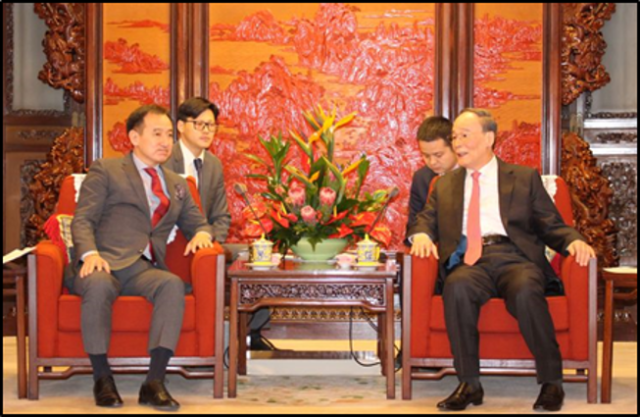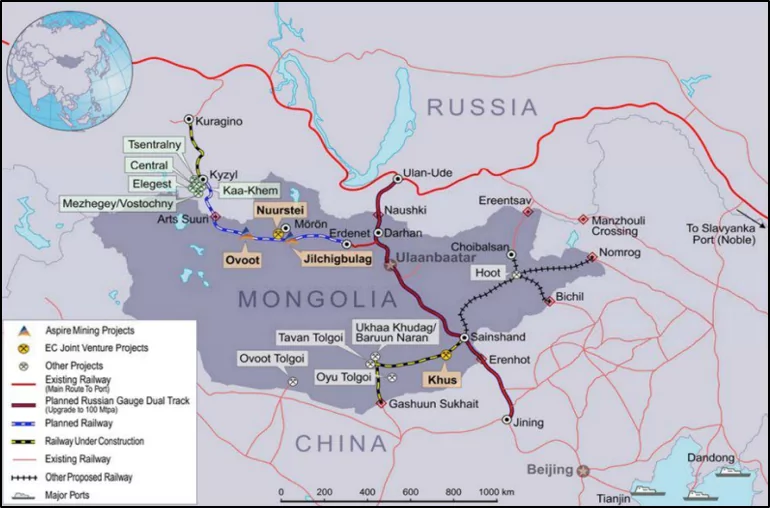
Mongolia and the Belt and Road Initiative: The Prospects for the China-Mongolia-Russia Economic Corridor
Publication: China Brief Volume: 20 Issue: 12
By:

Introduction
Mongolia is a landlocked country with a population of roughly 3.3 million people, bordering on only two nations, China and Russia. The country’s primary exports are largely minerals and raw materials, making trade with countries other than its immediate neighbors difficult. China’s Belt and Road Initiative (BRI)—and specifically, its primary Mongolian component, the China-Mongolia-Russia-Economic Corridor (CMREC)—promises to facilitate trade between Mongolia and its neighbors, as well as granting Mongolia access to overland routes to the European Union and sea ports in Asia.
The possibilities under BRI/CMREC have drawn praise from a number of voices in Mongolia. Demberel Sambuu, CEO of the Economic Research and Training Institute at the Central Bank of Mongolia, has stated that irrespective of the name given to it, the corridor is natural, inevitable, and necessary. [1] Lakshmi Boojoo, Director General of Mongolia’s Economic Policy and Competitive Research Center (EPCRC), agrees that the corridor is necessary, but that there are many considerations which must be taken into account before borrowing or spending begins. These factors include needs analysis, feasibility studies, regulatory reform, capacity building, and standardization, among others. [2]
Mongolia and Its Economic Relationship with China
During the period of the Mongolian People’s Republic (1924-1992), Mongolia was a client state of the USSR, and Soviet engineers built much of the country’s infrastructure, including the capital city of Ulaanbaatar. There was steady urbanization during this period, a trend that further accelerated after the fall of communism in the early 1990s. Today, over 65% of Mongolians are urban dwellers, with Ulaanbaatar accounting for 45% of the population (Statista, July 9; World Population Review, 2020). Mongolia is classified as a lower-middle income country, with a nominal annual GDP per capita in 2018 of $4,200 (CEIC Data, 2020).
Historically, Mongolia was almost completely dependent on animal husbandry; however, by 2014 exports accounted for more than half of Mongolia’s GDP. These exports include: copper, apparel, livestock, animal products, cashmere, wool, hides, fluorspar, other nonferrous metals, coal and crude oil. Mongolia’s primary export market is China, which purchases 84% of its export products (USTR, undated). As it is largely reliant on commodities exports—and a single, large export partner—the economy of Mongolia is directly dependent on both global prices for minerals and the performance of the Chinese economy. Conclusions reached by Mongolia’s Economic Policy and Competitive Research Center corroborate research conducted by international institutions: Mongolia needs diversification in both its exports and export partners, as well as a movement up the value chain. [3]
The BRI’s Attractiveness to Landlocked Countries
Mongolia’s status as a landlocked developing country (LLDC) poses particular challenges for its economy—a fact reflected in the creation of the United Nations-affiliated “International Think Tank for Land-Locked Developing Countries” in Ulaanbaatar (United Nations, June 11, 2018). The transportation infrastructure possibilities of the BRI hold particular attractiveness for Mongolia: speaking at the “Second Belt and Road Forum for International Cooperation” held in Beijing in April 2019, Mongolian Minister of Road and Transport Development Byambasuren Enkh-Amgala stated: “The BRI provides huge economic opportunities for landlocked countries like our country by mitigating their disadvantages of geographical position… Thus, Mongolia has actively participated in the BRI construction from the onset in order to accelerate its economic development by reducing the disadvantages associated with the lack of access to the sea” (Xinhua, April 26, 2019).
The Central Asian republics, which are the countries most similar in geography and circumstances to Mongolia, are landlocked members of the BRI. [4] Being landlocked dramatically decreases a country’s GDP: the average GDP of the Central Asian republics is only 57% of their neighboring countries who possess access to the sea. It has been estimated that export costs from the Central Asian states are 10% higher than those from countries with maritime access (CACI Analyst, April 30, 2018). Lakshmi Boojoo, Director General of EPCRC, estimates that export costs from Mongolia are even higher. Alongside the distances that must be travelled by rail and auto (both of which are less efficient than shipborne commerce), there is the additional problem of having to pay duties and meet standards for transshipping through a neighboring country. She estimates that this raises the cost of exports by as much as 40%. [5]
Mongolia’s total production is quite small. The factors of distance, difficulties in shipping, and regulatory restrictions all reduce Mongolia’s hopes of achieving economies of scale. These problems reduce the competitiveness of Mongolian exports, which in turn causes the country to focus on a very small number of products. In its recommendations to countries considering BRI investment, the World Bank recommends only making the investment when a country expects to achieve economies of scale (World Bank, undated). With Mongolia’s small population, that may be very difficult to achieve.
The realities of the economic challenges faced by landlocked countries help to explain why landlocked countries such as the Central Asian republics and Mongolia have embraced the BRI. LLDCs like Mongolia see the BRI as a means of obtaining financing for large scale infrastructure projects necessary for economic diversification, accelerated structural development, participation in regional cooperation, and increased trade. Through BRI projects, they can access funding from the Asian Infrastructure Investment Bank (AIIB) and other sources (CACI Analyst, April 30, 2018). The Central Asian republics have also joined the Shanghai Cooperation Organization (SCO)—in which both China and Russia are leading participants—thereby creating a platform for economic development and cooperation throughout the region. Mongolia has not formally joined the SCO, but enjoys observer status.

The China-Mongolia-Russia Economic Corridor
Plans to develop a “China-Mongolia-Russia Economic Corridor” (CMREC) were jointly announced in 2016 by the leaders of the three countries. A Xinhua statement at the time indicated that the three countries would “renovate ports of entry and overhaul customs procedures;” conduct “closer cooperation in energy and mineral resources, high tech, manufacturing, agriculture and forestry;” and “expand trade at border regions and widen services trade… [and promote] cooperation in education, science and technology, culture, tourism, medical care and intellectual property” (China Daily, September 16, 2016). Pursuant to these plans, the three countries have signed various agreements to cooperate on improving rail transit and highways through Mongolia, offering increased connections between China and Russia. Freight traffic has increased dramatically over the past few years: in 2014, only 10 China-Europe freight trains passed through Mongolia, but in 2018 there were around 900 (Xinhua, April 26, 2019).
The Mongolian government sees CMREC as a potential means of overcoming “landlockedness,” and as a program that could be integrated with Mongolia’s own domestic development plans. Mongolia is pursuing its own Steppe Road Plan, a reported $50 billion infrastructure development program announced in 2014 that aims to boost energy, telecommunications, mining, and tourism, as well as to build or upgrade road and transport infrastructure (Eurasia Net, July 7, 2017). The PRC has touted the BRI as being “highly consistent with Mongolia’s Steppe Road program,” and as an initiative that “will guide the win-win cooperation between the two countries” (Xinhua, October 2, 2016).
Amid its benefits, one of the most salient potential drawbacks for the BRI/CMREC is the implications that it bears for Mongolian sovereignty. The completion of CMREC would require a large investment in transportation infrastructure, thereby increasing Mongolia’s external debt, which already stands at 221% of nominal GDP (CEIC Data, 2020). Such a prospect carries the possibility of Mongolia being subjected to a BRI-related “debt trap” of the sort faced by countries such as Sri Lanka (China Brief, January 5, 2019; China Brief, April 13).
Analysis of the Economic Impact on Mongolia
The International Think Tank for Landlocked Developing Countries (ITTLLDC) in Ulaanbaatar has published models that examine three possible economic corridors, and their respective impacts on Mongolia and China. The models made several assumptions—including that the projects would be completed by 2020—and then measured what their impact would be in 2030. The models assumed that average highway speed would be raised from 19.25 kilometers per hour (km/h) to 38.5km/h, and that average rail speed would improve from 19.1km/h to 40.0km/h. The models further assumed that customs facilitations would be undertaken, cutting the time and cost of clearing borders in half (ITTLLDC, 2017).
Per this analysis, the first corridor, connecting China and Russia through the Western part of Mongolia, resulted in the largest economic benefit going to China. Consequently, ITTLLDC speculated that China might be most interested in funding this corridor. The second corridor, connecting China and Russia through Ulaanbaatar, benefited the largest number of countries—thus potentially making the project eligible for international funding through China, the EU, and Russia. The third corridor, connecting Bichigt, Mon and Ulaanbaatar, had a positive impact for both China and Mongolia—therefore raising the likelihood that the two governments might collaborate on funding (ITTLLDC, 2017).
Conclusion
Despite the benefits, economic corridors such as the envisioned CMREC also carry with them some risks. These include a massive inflow of foreign direct investment, which could crowd out or decimate local industries; as well as a dramatic increase in migrant labor and goods imports, which could threaten domestic small and medium sized enterprises. From a geopolitical standpoint, Mongolia also bears a certain amount of risk, as it must balance its engagement with Russia against its engagement with China, without alienating one or the other. Deeper engagement with China’s BRI program could offer considerable economic benefits to Mongolia—but it also presents complex political issues for Mongolia’s leaders to consider as they contemplate their country’s future.
Antonio Graceffo, PhD is an economic researcher and China analyst based out of Ulaanbaatar, Mongolia.
Notes
[1] Lakshmi Boojoo, Director General of Mongolia’s Economic Policy and Competitive Research Center, in-person interview conducted by the author, Ulaanbaatar, Mongolia (June 12, 2020).
[2] Demberel Sambuu, CEO of Economic research and Training Institute at Central Bank of Mongolia, social media interview conducted by the author (June 8, 2020); and follow-up in-person interview conducted by the author, Ulaanbaatar, Mongolia (July 8, 2020).
[3] China´s Belt & Road Initiative and the Economic Diversification of Landlocked Developing Countries: A New Pathway to Development? Mongolia Case Study. Bonn, Germany: Deutsche Gesellschaft für Internationale Zusammenarbeit (GIZ), 2014.
[4] Other noteworthy land-locked BRI states include: Afghanistan, Lao, Nepal, and Bolivia. Africa has the most landlocked BRI members: Burundi, Chad, Ethiopia, Lesotho, Niger, Rwanda, South Sudan, Uganda, Zambia, and Zimbabwe. Several of the European BRI members are also landlocked: North Macedonia, Moldova, Belarus, and Slovakia, as well as European Union members Austria and Hungary.
[5] Lakshmi Boojoo, Director General of Mongolia’s Economic Policy and Competitive Research Center, in-person interview conducted by the author, Ulaanbaatar, Mongolia (June 12, 2020).




